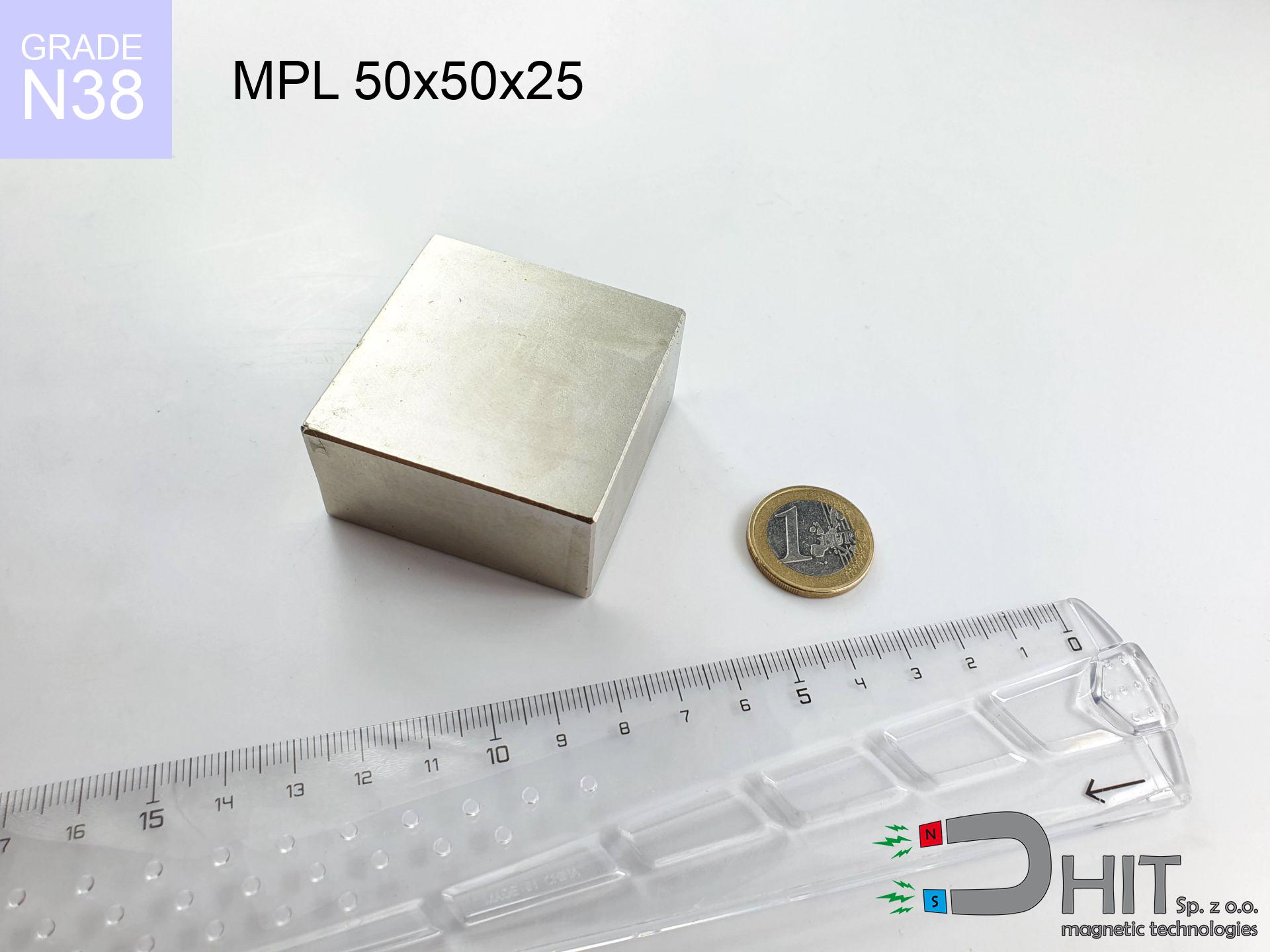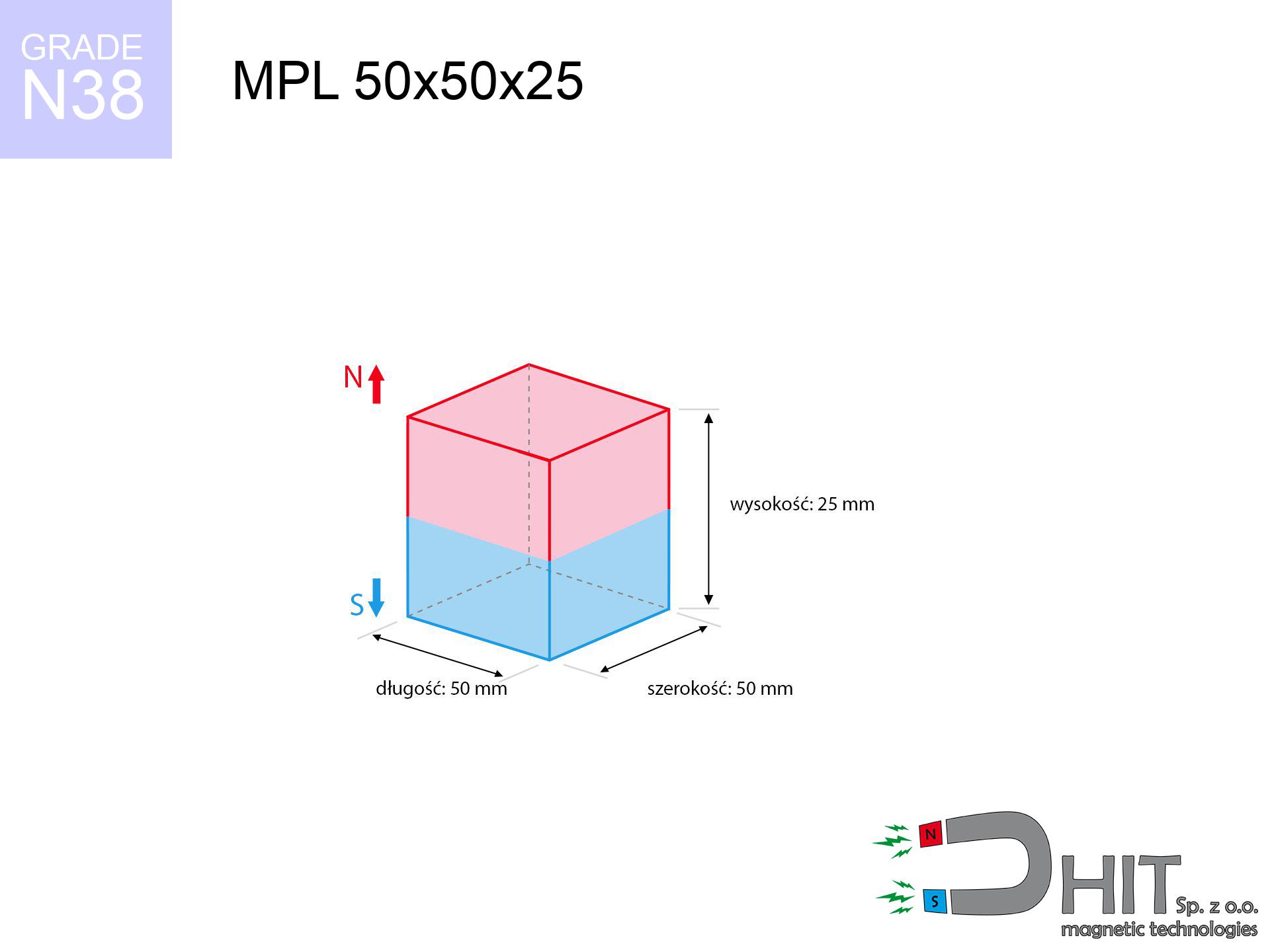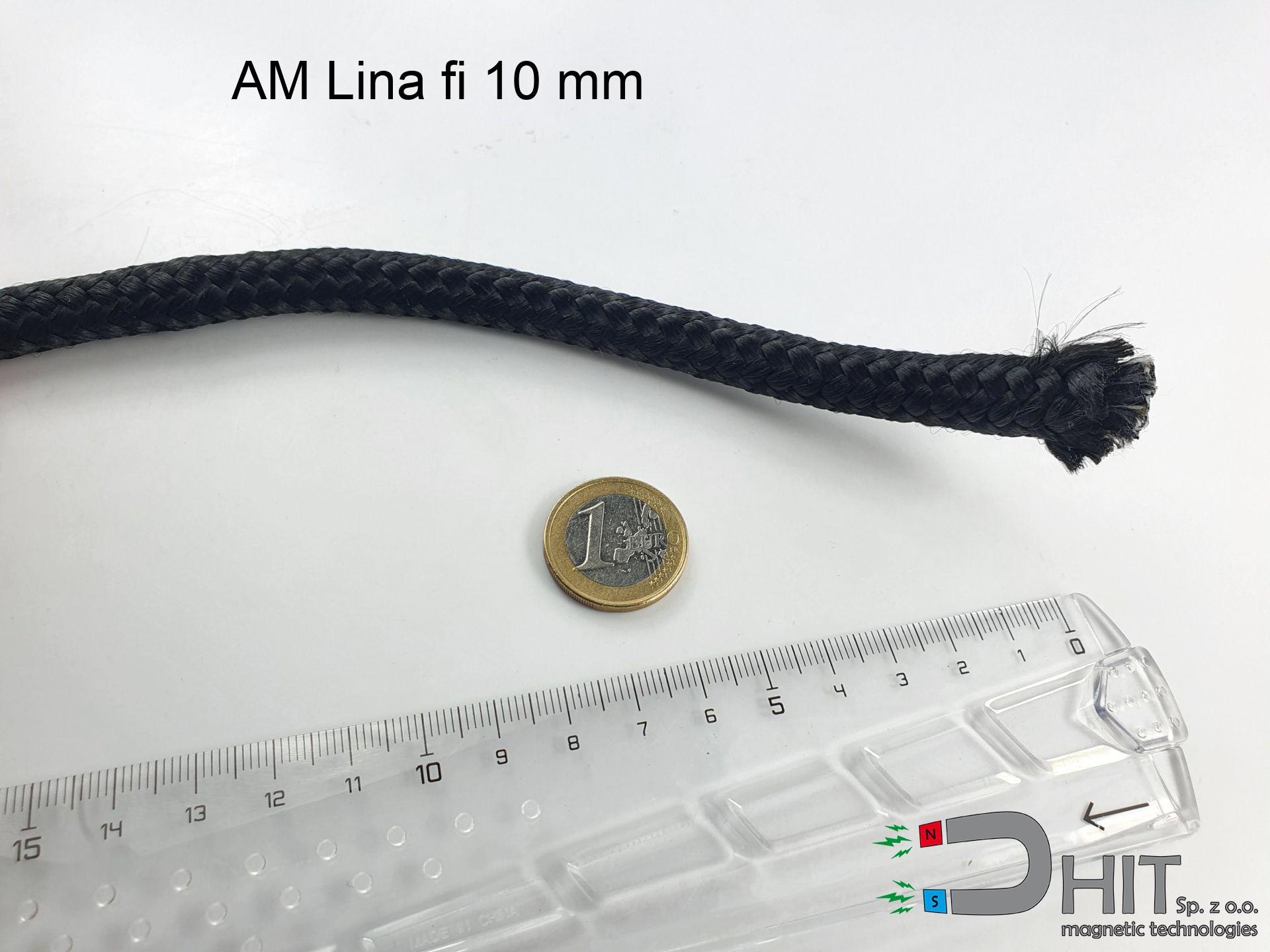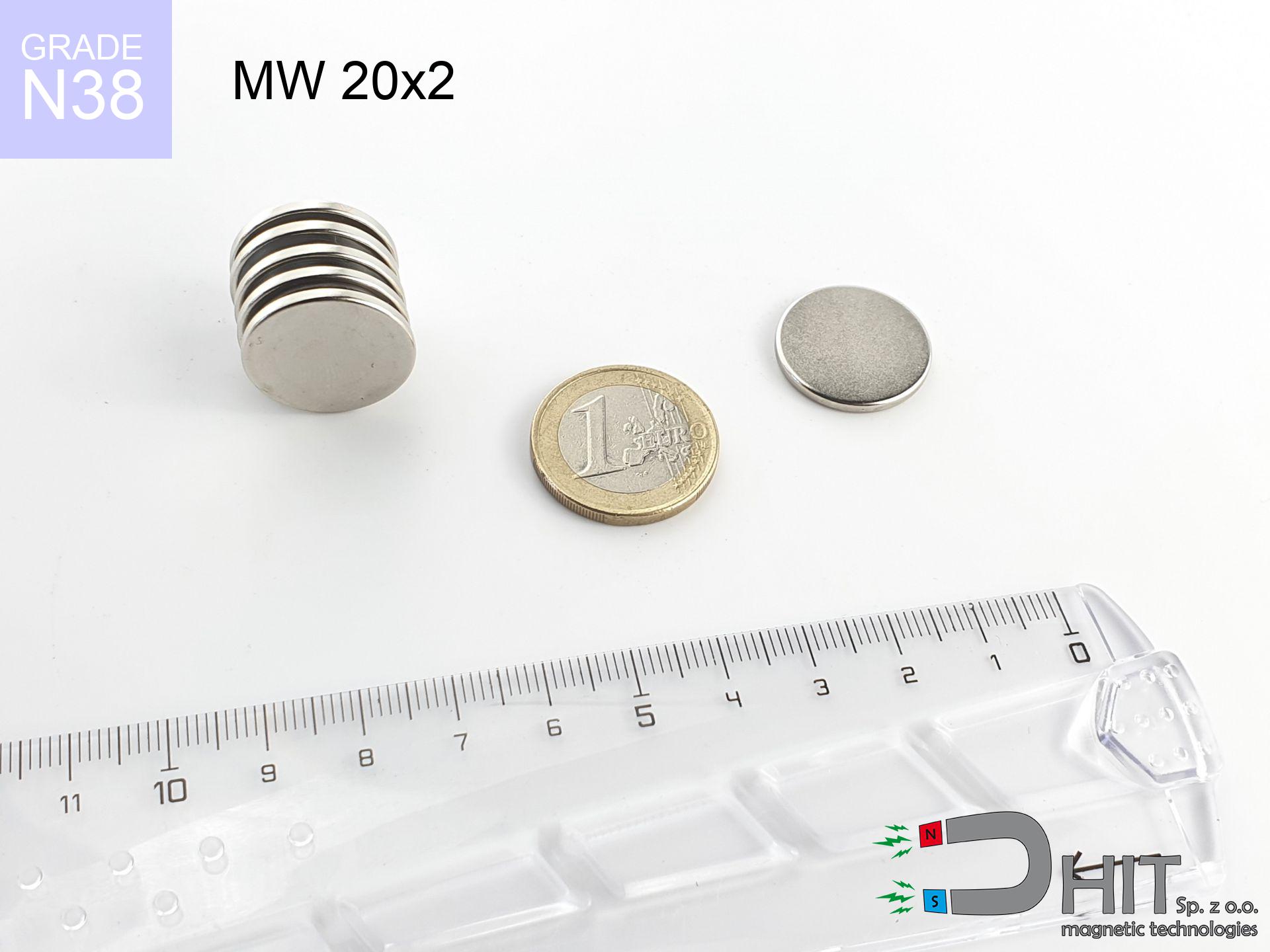MPL 50x50x25 / N38 - lamellar magnet
lamellar magnet
Catalog no 020168
GTIN: 5906301811749
length [±0,1 mm]
50 mm
Width [±0,1 mm]
50 mm
Height [±0,1 mm]
25 mm
Weight
468.75 g
Magnetization Direction
↑ axial
Load capacity
98.71 kg / 968.01 N
Magnetic Induction
413.25 mT
Coating
[NiCuNi] nickel
182.00 ZŁ with VAT / pcs + price for transport
147.97 ZŁ net + 23% VAT / pcs
bulk discounts:
Need more?Want to negotiate the price?
Call us +48 22 499 98 98 or write via form on the contact page. Test the magnet's power with our power calculator.
Orders placed by 14:00 are shipped the same day.
MPL 50x50x25 / N38 - lamellar magnet
Magnetic properties of material N38
Physical properties of NdFeB
Shopping tips
Due to their strength, flat magnets are frequently applied in devices that require exceptional adhesion.
Typical temperature resistance of flat magnets is 80 °C, but with larger dimensions, this value rises.
Additionally, flat magnets often have different coatings applied to their surfaces, e.g. nickel, gold, or chrome, for enhancing their durability.
The magnet named MPL 50x50x25 / N38 and a magnetic strength 98.71 kg weighing a mere 468.75 grams, making it the ideal choice for applications requiring a flat shape.
Contact surface: Due to their flat shape, flat magnets ensure a greater contact surface with adjacent parts, which is beneficial in applications requiring a stronger magnetic connection.
Technology applications: These are often applied in different devices, e.g. sensors, stepper motors, or speakers, where the thin and wide shape is important for their operation.
Mounting: This form's flat shape makes it easier mounting, especially when it is necessary to attach the magnet to another surface.
Design flexibility: The flat shape of the magnets permits designers greater flexibility in placing them in structures, which can be more difficult with magnets of more complex shapes.
Stability: In certain applications, the flat base of the flat magnet may provide better stability, minimizing the risk of sliding or rotating. However, one should remember that the optimal shape of the magnet is dependent on the specific application and requirements. In some cases, other shapes, such as cylindrical or spherical, are more appropriate.
Magnets have two poles: north (N) and south (S), which interact with each other when they are different. Similar poles, e.g. two north poles, act repelling on each other.
Due to these properties, magnets are commonly used in magnetic technologies, such as motors, speakers, sensors, or magnetic locks. Neodymium magnets stand out with the greatest strength of attraction, making them perfect for applications requiring powerful magnetic fields. Moreover, the strength of a magnet depends on its dimensions and the material it is made of.
It’s worth noting that extremely high temperatures, above the Curie point, cause a loss of magnetic properties in the magnet. The Curie temperature is specific to each type of magnet, meaning that under such conditions, the magnet stops being magnetic. Interestingly, strong magnets can interfere with the operation of devices, such as navigational instruments, magnetic stripe cards or medical equipment, like pacemakers. Therefore, it is important to avoid placing magnets near such devices.
Advantages as well as disadvantages of neodymium magnets NdFeB.
Besides their durability, neodymium magnets are valued for these benefits:
- They have constant strength, and over around 10 years their attraction force decreases symbolically – ~1% (according to theory),
- They remain magnetized despite exposure to magnetic surroundings,
- Thanks to the shiny finish and gold coating, they have an visually attractive appearance,
- They exhibit extremely high levels of magnetic induction near the outer area of the magnet,
- With the right combination of materials, they reach significant thermal stability, enabling operation at or above 230°C (depending on the design),
- With the option for tailored forming and targeted design, these magnets can be produced in various shapes and sizes, greatly improving engineering flexibility,
- Key role in new technology industries – they are utilized in computer drives, electromechanical systems, clinical machines as well as technologically developed systems,
- Thanks to their concentrated strength, small magnets offer high magnetic performance, while occupying minimal space,
Disadvantages of magnetic elements:
- They can break when subjected to a powerful impact. If the magnets are exposed to external force, we recommend in a metal holder. The steel housing, in the form of a holder, protects the magnet from damage while also increases its overall strength,
- They lose magnetic force at elevated temperatures. Most neodymium magnets experience permanent loss in strength when heated above 80°C (depending on the form and height). However, we offer special variants with high temperature resistance that can operate up to 230°C or higher,
- Due to corrosion risk in humid conditions, it is advisable to use sealed magnets made of plastic for outdoor use,
- Using a cover – such as a magnetic holder – is advised due to the restrictions in manufacturing fine shapes directly in the magnet,
- Possible threat linked to microscopic shards may arise, when consumed by mistake, which is crucial in the health of young users. It should also be noted that small elements from these devices can disrupt scanning if inside the body,
- In cases of mass production, neodymium magnet cost may be a barrier,
Handle Neodymium Magnets with Caution
Neodymium magnets are among the most powerful magnets on Earth. The surprising force they generate between each other can shock you.
To use magnets properly, it is best to familiarize yourself with our information beforehand. This will help you avoid significant harm to your body and the magnets themselves.
Neodymium magnets can demagnetize at high temperatures.
Even though magnets have been found to maintain their efficacy up to temperatures of 80°C or 175°F, it's essential to consider that this threshold may fluctuate depending on the magnet's type, configuration, and intended usage.
Neodymium magnetic are highly fragile, they easily crack as well as can become damaged.
Neodymium magnetic are highly fragile, and by joining them in an uncontrolled manner, they will crack. Neodymium magnets are made of metal and coated with a shiny nickel surface, but they are not as hard as steel. In the event of a collision between two magnets, there may be a scattering of fragments in different directions. Protecting your eyes is crucial in such a situation.
Make sure not to bring neodymium magnets close to the TV, wallet, and computer HDD.
The strong magnetic field generated by neodymium magnets can destroy magnetic media such as floppy disks, video tapes, HDDs, credit cards, magnetic ID cards, cassette tapes, etc. devices. They can also destroy videos, televisions, CRT computer monitors. Do not forget to keep neodymium magnets away from these electronic devices.
Neodymium magnets are not recommended for people with pacemakers.
Neodymium magnets produce strong magnetic fields that can interfere with the operation of a heart pacemaker. However, if the magnetic field does not affect the device, it can damage its components or deactivate the device when it is in a magnetic field.
Dust and powder from neodymium magnets are flammable.
Do not attempt to drill into neodymium magnets. Mechanical processing is also not recommended. Once crushed into fine powder or dust, this material becomes highly flammable.
Never bring neodymium magnets close to a phone and GPS.
Strong fields generated by neodymium magnets interfere with compasses and magnetometers used in navigation, as well as internal compasses of smartphones and GPS devices.
It is crucial not to allow the magnets to pinch together uncontrollably or place your fingers in their path as they attract to each other.
If joining of neodymium magnets is not under control, at that time they may crumble and crack. You can't move them to each other. At a distance less than 10 cm you should have them very strongly.
The magnet coating contains nickel, so be cautious if you have a nickel allergy.
Studies clearly indicate a small percentage of people who suffer from metal allergies such as nickel. An allergic reaction often manifests as skin redness and rash. If you have a nickel allergy, you can try wearing gloves or simply avoid direct contact with nickel-plated neodymium magnets.
It is important to keep neodymium magnets out of reach from children.
Neodymium magnets are not toys. Do not allow children to play with them. In the case of swallowing multiple magnets simultaneously, they can attract to each other through the intestinal walls. In the worst case scenario, this can lead to death.
Warning!
So you are aware of why neodymium magnets are so dangerous, read the article titled How dangerous are powerful neodymium magnets?.





![UMGW 75x33x18 [M10] GW / N38 - magnetic holder internal thread UMGW 75x33x18 [M10] GW / N38 - magnetic holder internal thread](https://cdn3.dhit.pl/graphics/products/umgw-75x33x18-m10-gw-cak.jpg)

![UMP 94x28 [3xM10] GW F300 GOLD / N38 - search holder UMP 94x28 [3xM10] GW F300 GOLD / N38 - search holder](https://cdn3.dhit.pl/graphics/products/ump-94x28-m10-gw-f300-vux.jpg)


